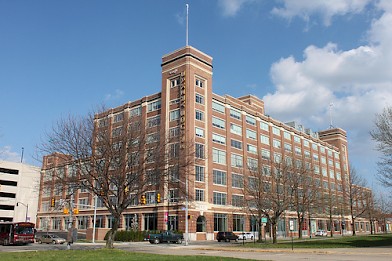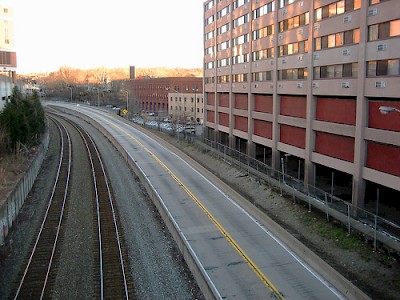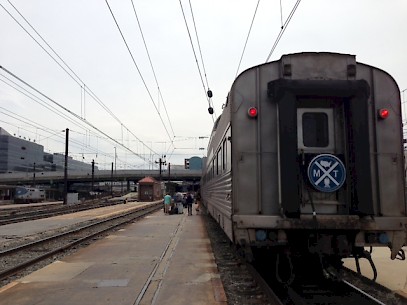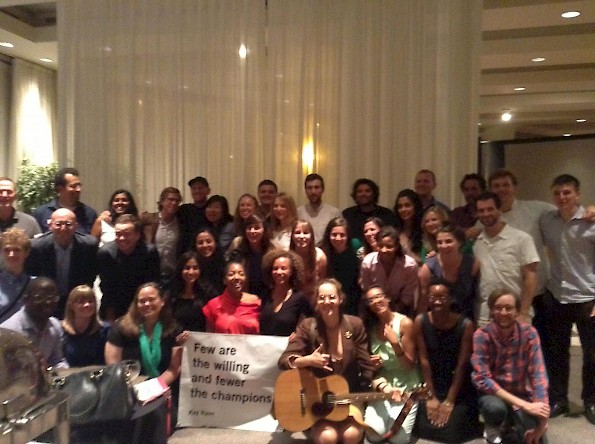Happening Now
Final Stops and New Beginnings: Pittsburgh to Washington, DC
August 19, 2013
Written By Malcolm Kenton
The Millennial Trains Project (MTP) private cars arrived early Friday morning (August 16) in the Steel City of Pittsburgh behind Amtrak’s eastbound Capitol Limited, and a Norfolk Southern diesel switched them onto track 2 (one of the two stub-end tracks at the former Pennsylvania Railroad station), in front of two other private cars which appeared to be unoccupied. Shortly after arrival, we headed out to explore a city that has done a lot to reinvent itself after the closure of the massive steel plants. The city has lost a lot of people, but has also seen the quality of its air and water improve dramatically. It boasts three highly-regarded universities, a resurgent downtown, and an abundance of parks and bicycle trails.

We took Port Authority transit buses east along Liberty Avenue to a new mixed-use development called Bakery Square, whose anchor tenant is Google’s Pittsburgh office. It has several restaurants and high-end stores, a central green with outdoor seating, and Pittsburgh’s (so far) only bikeshare station, for the use of the development’s residents. It also hosts a TechShop, only one of two of its kind east of the Mississippi (locations in Washington, DC and Brooklyn, NY are planned). TechShop members, after paying annual dues, have access to a large variety of equipment including 3D printers and welding, woodworking, metal cutting and sewing machines all driven by computers. This served as our hub for the day.
Located adjacent to Bakery Square, connecting downtown to the eastern part of the city, is the Busway: a two-lane road built parallel to the Norfolk Southern tracks (used by Amtrak’sCapitol Limited and Pennsylvanian) that is used only by transit buses and emergency vehicles. There are several bus stations along it, where fares are paid before boarding, so the buses act like a rail transit system. Many routes diverge from the Busway and serve various neighborhoods as regular transit buses (with fares paid on board), similar to the way streetcars mix street running with operation in a subway tunnel in the center city in Boston, Philadelphia and San Francisco. Pittsburgh also has two light rail lines that connect downtown with the southern part of the city and suburbs across the Monongahela River. A spur connecting light rail to the Amtrak station and main Post Office is still in place, but not currently used in revenue service. I had ridden light rail on previous trips. Finally, Pittsburgh boasts two historic incline railways, the Monongahela and Duquesne, which shuttle people up and down steep hills on the southern bank of the Monongahela, and are used daily by commuters.

I spent the day at TechShop conducting interviews with fellow passengers for my film, and being interviewed by a reporter with WESA, the city’s public radio station. After a short visit to the nearby East End Brewing Company (a warehouse houses local small businesses that make beer, coffee and sodas) and tasting a few beers, we took the bus back to the Amtrak station. After dinner on the train, we heard from Keith Bellows, Editor in Chief ofNational Geographic Traveler magazine. He offered up the following thoughts on how trains can best be positioned as a travel mode of choice:
Places and conveyances are trying to figure out how they can reach back to their true bearings. It’s about looking at the attributes you have that are just you, that aren’t made up. … Train travel has already gotten over the first hurdle in the Northeast Corridor. It’s already proven that it’s a much better method of travel than the airlines. … But what I’m feeling is that it’s trying to be modern, and not really bringing back the atmosphere, and the texture, and the home-spunness of what train travel is. So while it’s saying we’re competitive with the airlines, it’s not saying we’re also a wonderful experience. … [Railroads and their advocates should emphasize] what makes train travel truly romantic … where you’re willing to take the time out of your life to have something that’s a little bit more experiential.
Bellows also spoke of how important it is becoming for Americans to travel to gain a perspective of other lands and cultures, as an increasingly global world will otherwise leave us behind. Travel is the world’s fastest-growing business: more Americans visit Italy each year now than traveled outside the country at all in the 1950s, and the numbers of international visitors to the US are growing every year. The next big waves in travel will include purpose travel and service travel—where people go places to help people or make a difference rather than just vacation. “Travel is a lot more than just vacation,” he said. “I think it is one of the biggest forces for change in our lives.
One final word from Bellows: “Travel is a whole bunch more than just locomotion. And the locomotion that trains bring you, it’s not just intimacy. It brings you really a way of experiencing place, and that’s largely what we’re about at National Geographic.”
Saturday, our final day aboard the train, dawned misty as the train wound upstream along the Youghiogheny River. The experience of the Pittsburgh-Washington portion of the Capitol Limited’s journey is almost as sublime as crossing the Rockies, except the mountains (which are much older geologically than the Rockies) are covered in trees rather than colorful layers of bare rock. As clouds and fog gave way to patchy sunshine and we enjoyed the cresting of the Allegheny Summit on the Sand Patch Grade and the cruise down the Potomac River, we took part in a role-playing exercise led by Rhett Weiss, Executive Director of Cornell University’s Entrepreneurship Institute. We divided into groups of three, where one was the owner of a small electronics store and the other two were customers in different situations who each needed a cell phone fixed or replaced. Based on what we knew about our characters, we had to negotiate a deal that would satisfy all three parties. As has happened each previous time Weiss led this exercise, each party reached a different deal and took varying amounts of time to reach a deal. He used this experience to teach about being aware of multiple dynamics in a negotiation.

Our final speaker, who took us from Cumberland to Harpers Ferry, was Jonathon Perelli, the founder of 1776, a start-up incubator space in Washington, DC (patterned after Chicago’s 1871). We pulled into Track 14 at Washington Union Station around 1:30 PM Saturday afternoon and had a late lunch at Center Café in Union Station’s main hall. That evening, at a reception at National Geographic Society headquarters, each participant in the trip had one minute to explain and make a pitch for his or her project to an audience that included most of MTP’s sponsors and many family and friends. I used my minute to deliver the following words, which received a rousing ovation:
Trains are uniquely conducive to social interaction amongst travelers, and the way that the landscape is experienced through a train window gives rise to contemplation and creativity, as well as increased awareness of both ecological and human landscapes--the way they are and the way they could be. Railroads create places--Interstate highways and air travel corridors only followed the existing patterns of settlement established by the railroads. And not only that, but the places that grow around train stations and transit lines tend to be healthier, more livable communities where more amenities are within walking and biking distance of homes.
Reawakening the romance of train travel in our generation--making trains desirable not just as a convenient, affordable, low-impact way to get around but also as an enjoyable and life-affirming travel experience--will provide the impetus for rail revitalization to be an integral part of the transformative social movement that our generation must lead if we are to have a more sustainable existence on a living planet.
We need an expanded train network, both within and between cities, to revitalize America and reshape it in a way that is resilient in the face of climate change. I aim to show more people what a refreshing experience train travel is compared to driving and flying, and give them a sense of the possibilities for the kind of country we could be if, once again, train travel were the norm rather than the exception in transportation--and if we had more train routes and more frequent trains serving all corners of this country.
I work for the country's oldest and largest advocacy group for passenger trains, the National Association of Railroad Passengers. I hope you'll consider supporting our work. Please visit www.NARPrail.org
The inaugural MTP journey formally ended Sunday morning with a get-together to debrief and give feedback at the gorgeous Evermay Estate in Georgetown, home of the S&R Foundation, one of MTP’s sponsors. All participants promised each other we would keep in touch, and that evening, those participants who live in the DC area started our own email list to let each other know what we were doing in town. Meanwhile, MTP is already planning its next two crowd-funded train trips for enterprising Millennials: Los Angeles to Miami in March 2014, and Portland, OR to New York City in August 2014.
-Malcolm Kenton

"Thank you to Jim Mathews and the Rail Passengers Association for presenting me with this prestigious award. I am always looking at ways to work with the railroads and rail advocates to improve the passenger experience."
Congressman Dan Lipinski (IL-3)
February 14, 2020, on receiving the Association's Golden Spike Award
Comments